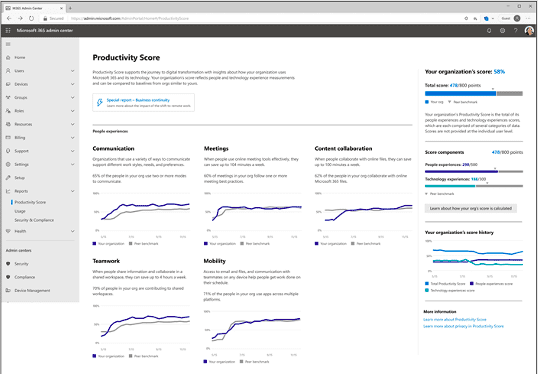The business world has gone through a digital transformation over the last 20 years, and some would say that several years of evolution were compacted into one during 2020 because of the pandemic.
Companies had to quickly adapt to completely virtually run offices, which meant transitioning to cloud platforms that enabled remote connectivity, like Microsoft 365.
To give you an idea of how dramatic this “all cloud all the time” evolution has been because of COVID, here are some of the Microsoft Teams usage statistics pre pandemic and after the pandemic began.
Number of Microsoft Teams Users:
- November 2018: 8 million (pre pandemic)
- November 2019: 20 million (pre pandemic)
- November 2020: 115 million (post pandemic)
After getting over the hurdle of moving to the cloud and platforms like Microsoft 365 to power remote teams, businesses now have the challenge of how to track productivity in this new environment.
One benefit of a collaborative cloud-based environment is that you have transparency into productivity that you don’t have when everyone is working in offline software on their own device.
Microsoft has taken advantage of this transparency and created a tool for companies to gain insights into both team and process efficiency, called Microsoft Productivity Score.
What is Microsoft Productivity Score?
Microsoft Productivity Score is a tool that M365 business users can access to gain insight into the efficiency of its digital transformation journey. The tool provides data on productivity and where it can be improved.
Also included are recommended actions to help a team to use Microsoft 365 apps more efficiently.
There are two main areas the tool looks at, people and technology.
People Experiences
This looks at how well your employees are using the productivity features of the Microsoft 365 platforms. Such as whether or not they’re collaborating regularly, using content sharing features, and communication with each other.
Where does Microsoft get best practices variables for how it grades people? From public research on organizational effectiveness. One example it gives is that research shows if people share content via cloud instead of through email attachments, they can save up to 100 minutes per week. This is the type of variable that goes into the tool’s scoring.
Technology Experiences
The second area that Microsoft Productivity Score looks at is your technology and how it’s performing. Are there any problems with hardware slowing your team down? Do you have any software issues dragging down productivity?
Endpoint analytics are used to help grade performance and health of all the tools your team uses, both hardware and software.
What Variables Are Included in the Productivity Score?
In each of the two areas, people and technology, are several different variables that the tool looks at in order to provide insights and recommendations for productivity improvements.
People Experiences
Five different categories are reviewed, including:
- Communication
- Content Collaboration
- Mobility
- Meetings
- Teamwork
The tool matches how your team works against best practices for time savings. For example, it might look at how much email is being used as compared to team chat, how much people are collaborating, and whether your files are set up for the easiest access paths.
Technology Experiences
Three categories are considered for technology health, including:
- Endpoint Analytics
- Network Connectivity
- Microsoft 365 Apps Health
The technology area is reviewing things like how well your network is performing and whether slow connectivity is slowing down your team. Endpoint health can also be tracked well as how optimally your Microsoft 365 apps are performing.
Reporting & Scoring
Between the two main areas, people and technology, there are eight total categories. Each of those categories has a total of 100 points that you can earn for a total for the productivity score of 800 points.
Productivity Score can be accessed in the Microsoft 365 Admin Center by an admin. To access the tool, you need either a Microsoft 365 for business or Office 365 for enterprise subscription.

Image from Microsoft
Once you’ve accessed the tool, you’ll see a score that is updated daily and reflects user actions from the last 28 days.
You’ll find scoring in each of the eight categories and suggestions on how to raise your score.
App Activity That’s Included
The Productivity Score data includes activities from the following Microsoft apps:
- Exchange
- SharePoint
- OneDrive
- Teams
- Word
- Excel
- PowerPoint
- OneNote
- Outlook
- Yammer
- Skype
Special Report
To help improve business continuity, Productivity Score includes a special business continuity report.
This is a limited-time Workplace Intelligence report designed to help organizations stay resilient in the face of unexpected circumstances.
The report is designed around the shift to remote working environments offers insights into things like work-life balance and how a shift to remote teams impacts office productivity.
Are You Getting the Most From Your Microsoft 365 Subscription?
Many Charlotte area companies only get a fraction of the productivity they could from Microsoft 365 because they don’t have proper guidance. Rocky Knoll Technologies help you use the platform to its fullest.
Contact us today to schedule a free consultation. Call 704.594.7292 or reach us online.



